Grizzly bears have a reputation as ferocious, horrifying predators that most people try to avoid in the wild. Even their taxonomic name, Ursus arctos horribilis, translates to horrible bear. The incredible grizzly bear’s size, speed, strength, and senses make it very dangerous. Which brings up the question: just how big can they get? While large on average, in this article we’re looking at the largest grizzly bear on record.
What is a grizzly bear?
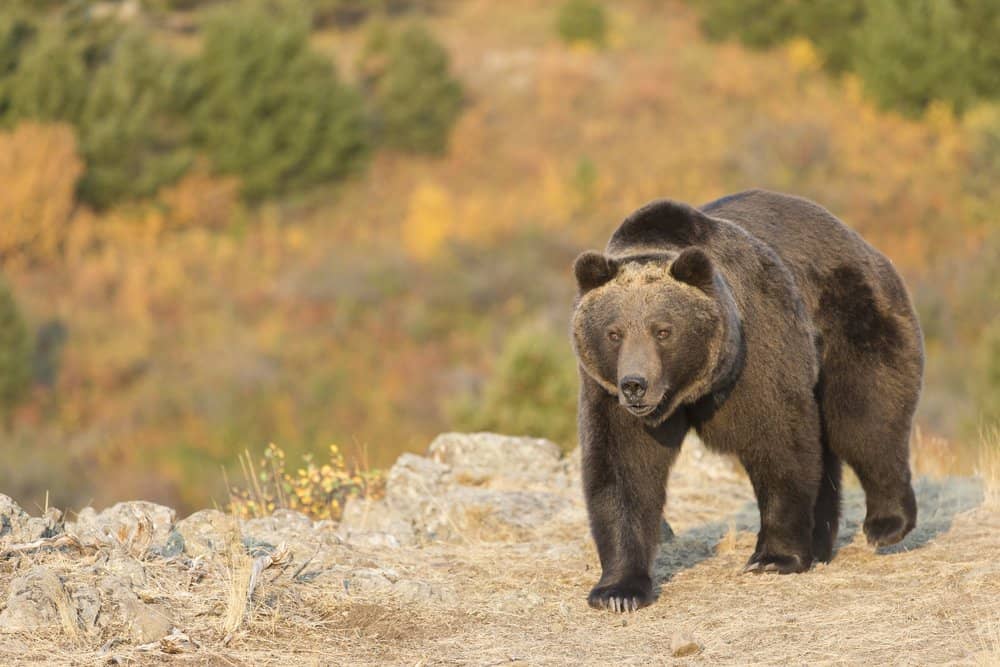
The Grizzly bear is a member of the brown bear family
©Dennis W Donohue/Shutterstock.com
Grizzly bears are a subspecies of brown bears that currently live in North America. There are more subspecies of brown bears than any other bear species! Other subspecies of brown bear include the Kodiak bear that inhabits Alaska’s Kodiak Islands, the Eurasian brown bear, the Syrian brown bear, the Tibetan blue bear, the Manchurian grizzly bear, the Himalayan brown bear, the Gobi bear, and the Kamchatkan brown bear. Other subspecies have existed but are now extinct. Despite the wide geographic distribution of brown bears around the world, grizzly bears live only in Alaska, western Canada, and the northwest United States. The average lifespan of a grizzly in the wild is 20-25 years.
Grizzly bears are omnivores and therefore have a diet of both plants and animals. Unlike their close relatives the polar bears, grizzly bears are hypocarnivores. Polar bears are classified as hypercarnivores because their diet consists of more than 70% meat. Grizzly bears, however, are hypocarnivores because they have a diet that consists of less than 30% meat, thus relying more heavily on other food sources. The 30% of their diet that includes meat consists of large prey such as moose, elk, caribou, white-tailed deer, mule deer, bison, and bighorn sheep. Grizzly bears also prey upon salmon, trout, and bass. The herbivorous component of their diet includes grasses, nuts, tubers, and various berries.
How do grizzly bears compare to other bear species?
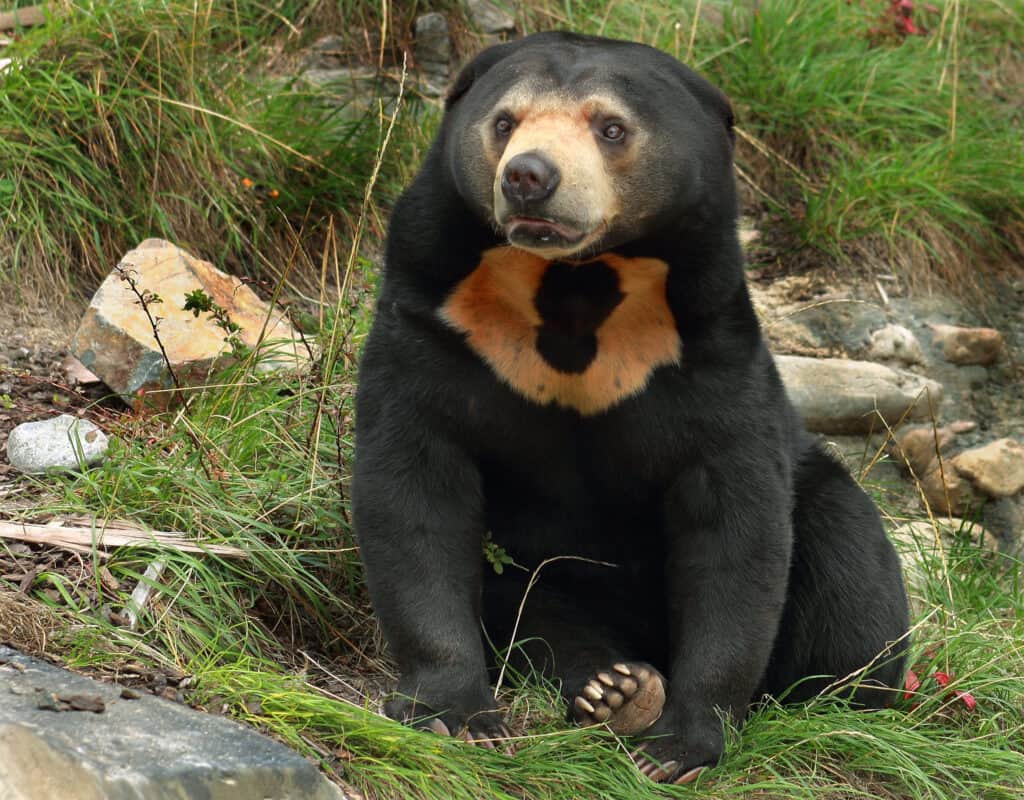
A sun bear, pictured here, is much smaller than a grizzly bear.
©Molly NZ/Shutterstock.com
Brown bears are one of eight species of bears. There are numerous subspecies to each species, however, including the grizzly bear. The largest of all bear species, and one of the largest land mammals in North America, is the polar bear (Ursus maritimus). Male polar bears typically weigh between 770-1,540 pounds! The largest subspecies of brown bears is the Kodiak bear which typically weighs 660-1,320 pounds! The smallest bear species is the sun bear which typically weighs between 55 and 143 pounds.
How do grizzly bears get so big?
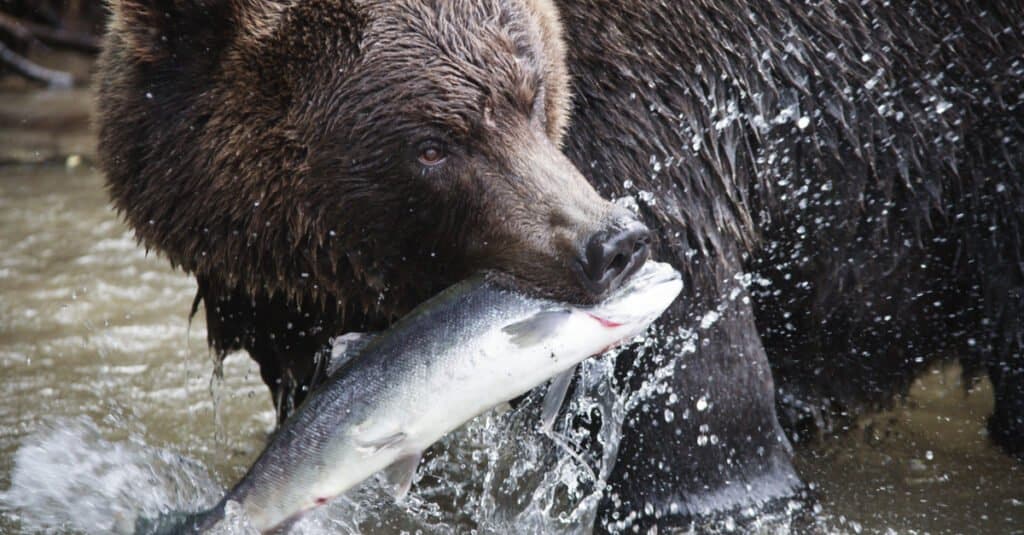
Grizzly bears eat large game, fish, and a variety of plants.
©DPS/Shutterstock.com
Grizzly bears achieve their largest sizes when preparing for hibernation. Bears typically hibernate in dens, hollowed trees, and holes they dig in the ground. To learn more about hibernation and where bears hibernate, click here. Hibernation is when an animal enters a state of dormancy that slows its metabolic rate. During winter, when food is scarce, grizzly bears hibernate so they can subsist on resources they accumulate and consume before winter comes. The slow metabolic rate associated with hibernation means that the bear is expending less energy by breathing slower, having a lower heart rate, and having a lower body temperature. The time before hibernation is characterized by hyperphagia, which means excessive eating. During this time, a grizzly bear’s size can increase by 400 pounds!
Grizzly bears are large in general for many evolutionary reasons. One interesting phenomenon in evolutionary biology pertaining to size is known as Bergmann’s rule. Bergmann’s rule states that species and subspecies that inhabit colder environments will be larger than subspecies that inhabit warmer environments. This is because larger and rounder animals have a better surface-area-to-volume ratio, which is advantageous for conserving heat. For example, the grizzly bear, which inhabits northern environments, is much larger than the sun bear which inhabits the hotter clime of southeastern Asia.
What is the largest grizzly bear ever recorded?
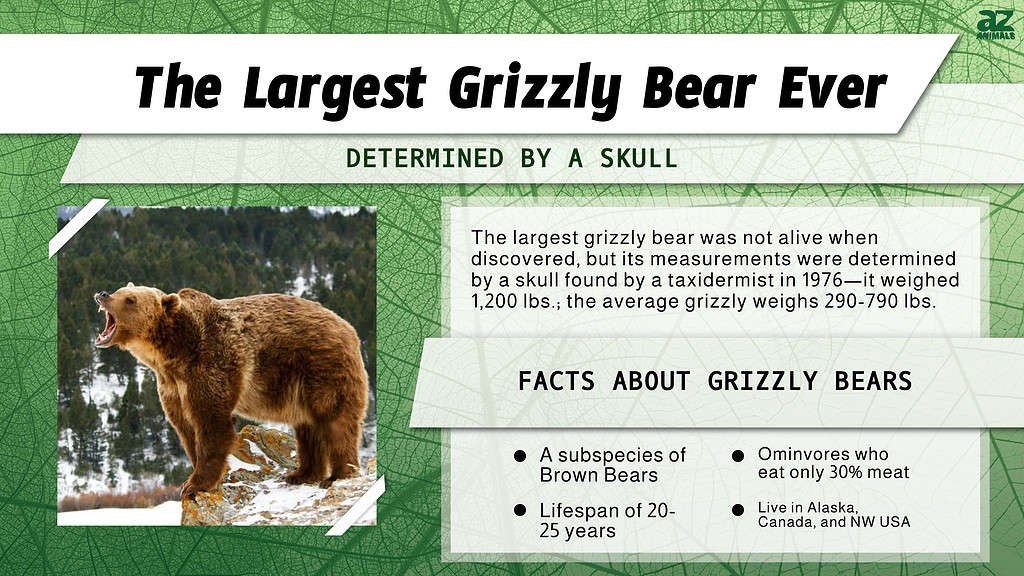
The largest grizzly bear ever recorded was actually not alive when discovered. Its measurements were determined by a skull found by a taxidermist in 1976. In 2014, the second largest grizzly skull was recorded from a hunter who shot a bear with a skull measuring 27 and 6/16th inches in length. Since the bears are so large and often skinned where shot, there aren’t normally weight measurements taken of these giants.
So, how much did the heaviest grizzly bear weigh? The most frequently cited giant grizzly weighed about 1,200 pounds.
That figure will vary from what you might read across the Internet. There is a common tale of a U.S. forest service worker who shot a massive grizzly that weighed 1,600 pounds. Various reports will even claim the bear was a man-eater and was brought down with a pistol. Unfortunately, these reports are fabrications of an actual hunt that shot a bear that measured 10 feet 6 inches from head-to-toe and may have weighed up to 1,200 pounds. That’s still a very large bear, but it’s a far cry from the 1,600-pound claim.
It’s likely grizzlies can reach weights larger than this, so perhaps we’ll see a new record size soon. The Kodiak brown bear species has a world record weight of 1,656 pounds (more on this below).
Even so, at 1,200 pounds this large bear greatly surpasses the average grizzly bear size. On average, female grizzly bears weigh 290-400 pounds. Male grizzly bears usually weigh between 400-790 pounds; however, coastal populations can weigh an average of 899 pounds. Typical weight varies widely depending on geographic distribution, environmental factors, and available resources.
How big is the largest of the other species?
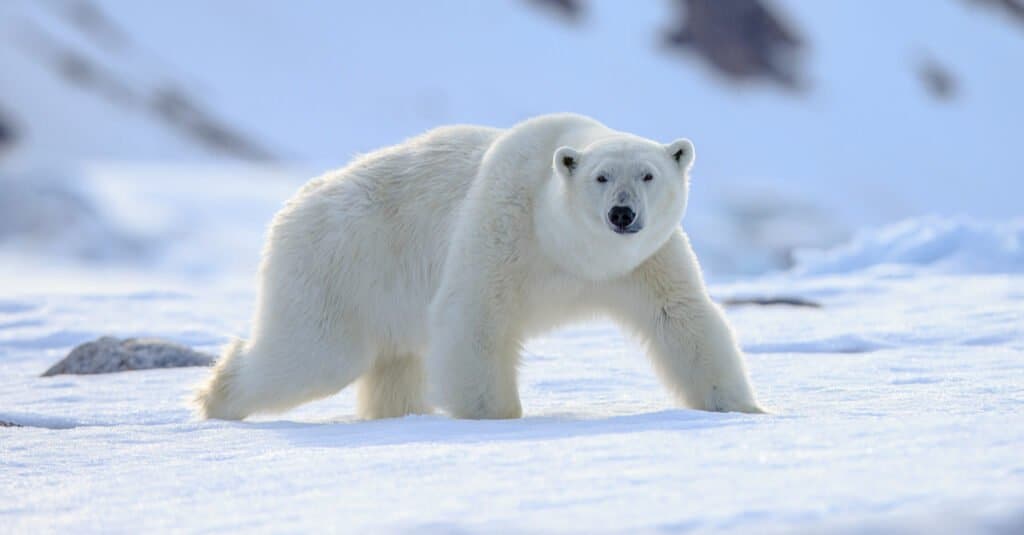
Polar bears are the largest species of bears.
©Vaclav Sebek/Shutterstock.com
The largest polar bear ever recorded was hunted in Alaska and weighed 2,209 pounds! That’s over three times the size of the average grizzly! The largest wild Kodiak bear ever recorded was found in Alaska and weighed 1,656 pounds! The largest American black bear was a male shot in New Brunswick, Canada that weighed 902 pounds.
How are grizzly bears doing today?
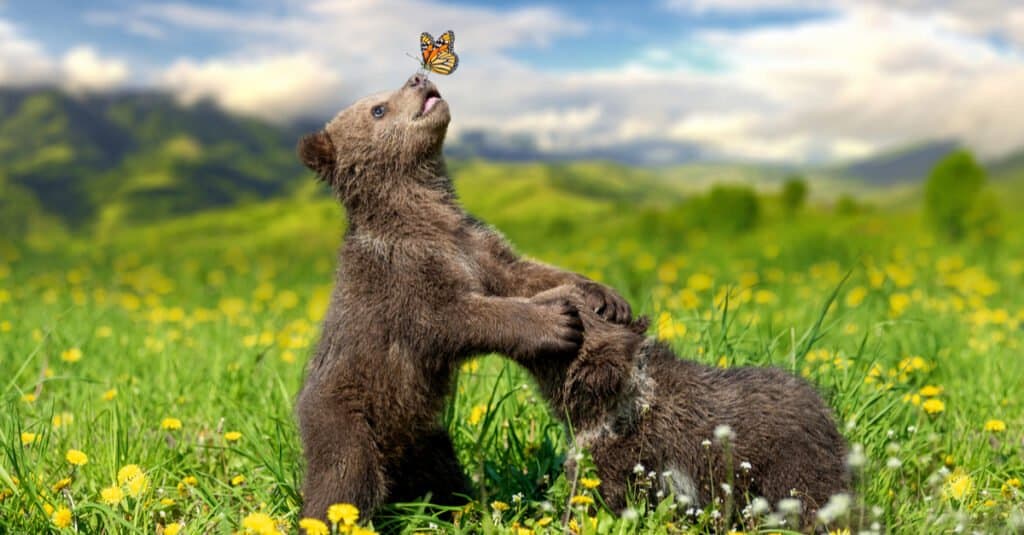
Two young grizzly bear cubs in a meadow.
©Volodymyr Burdiak/Shutterstock.com
Grizzly bear populations have been decreasing immensely in size over the past several decades. Outside of Alaska, only 1,500 grizzly bears live in the United States. The once abundant California grizzly bear that adorns its state flag is now extinct. Conservation efforts have included the establishment of protected areas and parks, protection under the Endangered Species Act, and attempts to connect populations that have been reproductively isolated due to human-made barriers. A notable organization at the forefront of grizzly bear conservation efforts in the lower 48 states is the Interagency Grizzly Bear Recovery Committee. This committee has designated five different “recovery zones” within which they implement various monitoring and conservation strategies. Grizzly bears, as a subspecies, do not have a conservation status listed by the IUCN Red List.
Bear Attacks
Unfortunately, there are an average of 11 bear attacks every year in the United States, as well as attacks in other countries where bears reside. The most common reason for these attacks is habitat loss due to urban expansion. When encountering a human, bears may attack either to defend themselves or their young. Of the types of bears that attack in North America, brown bears are considered to be the most dangerous and the grizzly is a subspecies of the brown bear.
When encountering any bear in the wild–black, brown, or polar–a human should treat it as a deadly threat and act accordingly. If encountering a brown bear like a grizzly, it is advised to stay calm and slowly back away while facing the bear, speaking in an appeasing voice. If the bear continues an advance towards you, you can use bear pepper spray at a range of 10 meters, then quickly leave the area. The third option is to play dead by going into a fetal position, protecting your neck and head, and positioning your backpack to protect you if you have one. If the bear doesn’t feel threatened, it will likely leave.
The photo featured at the top of this post is © Scott E Read/Shutterstock.com
Thank you for reading! Have some feedback for us? Contact the AZ Animals editorial team.






